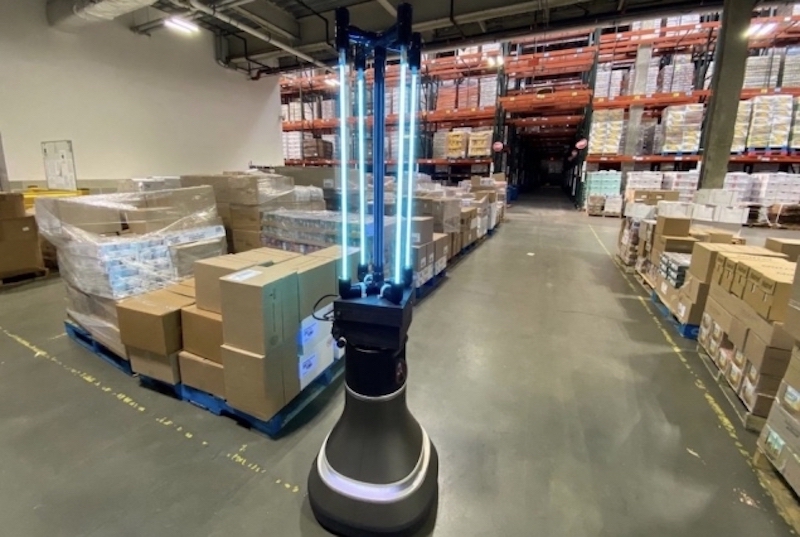Logistics / Public health
Disinfecting robot could help tackle COVID-19 in multiple settings
By Andrew Sansom | 01 Jul 2020 | 0
A team from the Massachusetts Institute of Technology (MIT’s) Computer Science and Artificial Intelligence Laboratory (CSAIL), in collaboration with Ava Robotics and the Greater Boston Food Bank (GBFB), has designed a new robotic system said to be capable of disinfecting surfaces and neutralising aerosolised forms of the coronavirus.
The solution, which uses a custom-designed UV-C light fixture that is integrated with Ava Robotics’ mobile robot base system, can apparently disinfect a warehouse floor in half an hour – and could one day be employed in grocery stores, schools, factories and restaurants.
UV-C light has proven to be effective at killing viruses and bacteria on surfaces and aerosols, but it’s unsafe for humans to be exposed. Ava’s telepresence robot, however, needs no human supervision. The team replaced the telepresence top with a UV-C array for disinfecting surfaces. The array is said to use short-wavelength ultraviolet light to kill microorganisms and disrupt their DNA in a process called ultraviolet germicidal irradiation.
“Food banks provide an essential service to our communities, so it’s critical to help keep these operations running,” says Alyssa Pierson, CSAIL research scientist and technical lead of the UV-C lamp assembly. “Here, there was a unique opportunity to provide additional disinfecting power to their current workflow and help reduce the risks of COVID-19 exposure.”
Testing the robot
The complete robot system is capable of mapping the space – in this case, GBFB’s warehouse – and navigating between waypoints and other specified areas. In testing the system, the team used a UV-C dosimeter, which confirmed that the robot was delivering the expected dosage of UV-C light predicted by the model.
During the tests at GBFB, the robot was able to drive by the pallets and storage aisles at a speed of roughly 0.22 miles per hour. At this speed, the robot could cover a 4000 sq ft space in the warehouse in just half an hour. The UV-C dosage delivered during this time can neutralise approximately 90 per cent of coronaviruses on surfaces, says the MIT researchers. And for many surfaces, this dose will be higher, resulting in more of the virus neutralised.
Typically, ultraviolet germicidal irradiation is used largely in hospitals and medical settings, to sterilise patient rooms and stop the spread of microorganisms, while also working against airborne pathogens. It’s said to be most effective in the direct “line of sight”, but it can get to nooks and crannies as the light bounces off surfaces and onto other surfaces, says the team. 
“Our 10-year-old warehouse is a relatively new food distribution facility with AIB-certified, state-of-the-art cleanliness and food safety standards,” says Catherine D’Amato, president and chief executive of the Greater Boston Food Bank. “COVID-19 is a new pathogen that GBFB and the rest of the world was not designed to handle. We are pleased to have this opportunity to work with MIT CSAIL and Ava Robotics to innovate and advance our sanitation techniques to defeat this menace.”
As a first step, the team teleoperated the robot to teach it the path around the warehouse. It can travel to defined waypoints on its map, such as going to the loading dock, then the warehouse shipping floor, then returning to base. Waypoints are defined from the expert human user in teleop mode, with new waypoints added to the map as needed.
The importance of the shipping area
At GBFB, the research team identified the warehouse shipping floor as a “high-importance area” for the robot to disinfect. By focusing on the shipping area, it prioritises disinfecting items leaving the warehouse to reduce COVID-19 spread out into the community.
One challenge is that the shipping area is constantly changing, so each night, the robot encounters a slightly new environment. When the robot is deployed, it doesn’t necessarily know which of the staging aisles will be occupied, or how full each aisle might be. Therefore, the team notes that they need to teach the robot to differentiate between the occupied and unoccupied aisles, in order that it can change its planned path accordingly.
“As we drive the robot around the food bank, we are also researching new control policies that will allow the robot to adapt to changes in the environment and ensure all areas receive the proper estimated dosage,” says Pierson. “We’re focused on remote operation to minimise human supervision and, therefore, the additional risk of spreading COVID-19, while running our system.”
For immediate next steps, the team is focused on increasing the capabilities of the robot at GBFB, as well as eventually implementing design upgrades. Their broader intention focuses on how to make these systems more capable at adapting to our world: how a robot can dynamically change its plan based on estimated UV-C dosages; how it can work in new environments; and how to co-ordinate teams of UV-C robots to work together.
“We’re excited to see the UV-C disinfecting robot support our community in this time of need,” says CSAIL director and project lead Daniela Rus. “The insights we received from the work at GBFB has highlighted several algorithmic challenges. We plan to tackle these in order to extend the scope of autonomous UV disinfection in complex spaces, including dorms, schools, airplanes and grocery stores.”
Organisations involved

